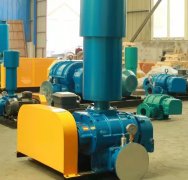Introduction to Roots blower used in powder negative pressure feeding system

The Roots blower used in the powder negative pressure feeding system is a key equipment, and its detailed introduction is as follows:
1、 Working principle
Roots blower is a positive displacement fan that operates based on the relative motion of two blade rotors (usually three bladed impellers) within a cylinder. When the motor drives one of the impellers to rotate, the other impeller will rotate synchronously at the same speed and in the opposite direction through the action of the synchronous gear. Due to the gaps between impellers, impellers and casings, and impellers and wall panels, a vacuum state is formed at the inlet during the rotation of the impeller, and air is drawn into the inlet chamber under atmospheric pressure. As the impeller continues to rotate, two of the blades of each impeller form a sealed chamber with the wall panel and casing, and the air in the intake chamber is continuously carried to the exhaust chamber by the sealed chamber formed by these two blades. Also, because the impellers in the exhaust chamber are interlocked, the air between the two blades is squeezed out. Through continuous inhalation and compression, air is transported from the inlet to the outlet on site, completing the entire gas transportation process.
In the powder negative pressure feeding system, the Roots blower generates negative pressure at the air inlet through its rotation. This negative pressure environment causes the powder material in the storage bin or container to be subjected to the external atmospheric pressure, and thus sucked into the intake duct of the blower. The inhaled material is pushed forward along the pipeline by the Roots blower, achieving the transportation of powder.
2、 Characteristics
1. Stability: The Roots blower adopts advanced design concepts and manufacturing processes, which can provide stable and continuous airflow, ensuring smooth transportation of powder materials in pipelines and improving transportation efficiency.
2. Flexible regulation: Roots blowers are usually equipped with regulating devices such as frequency converters, throttle valves, etc., which can adjust the fan speed and air volume according to actual needs, thereby achieving control over material conveying speed and flow rate.
3. Wide application range: Roots blower is suitable for conveying various materials such as powder, particle, fiber, etc., and can be widely used in industries such as chemical, grain, pharmaceutical, building materials, etc.
4. Easy maintenance: The structure of Roots blower is relatively simple and easy to maintain. At the same time, its long service life can reduce the maintenance and replacement costs of enterprises.
3、 Selection and Parameters
When selecting, it is necessary to consider performance parameters such as the speed, pressure, flow rate, shaft power, and exhaust temperature of the Roots blower. These parameters will directly affect the working effect of Roots blower in the powder negative pressure feeding system. Specifically:
1. Speed: The number of revolutions of the active shaft of a Roots blower per unit time is called the fan speed. The speed of rotation will affect the gas delivery capacity of the fan.
2. Pressure: The gas pressure at the flange of the intake and exhaust ports of the Roots blower, divided into intake pressure and exhaust pressure. In the powder negative pressure feeding system, attention should be paid to the negative pressure generation capacity of the fan.
3. Flow rate: The mass or volume of gas passing through a fan section per unit time is called the mass or volume flow rate of gas passing through that section. In the powder negative pressure feeding system, the flow rate will determine the conveying speed of the material.
4. Shaft power: The power transmitted from the prime mover to the main shaft of a Roots blower per unit time under flow and head conditions. The magnitude of shaft power will affect the energy consumption and operating costs of the fan.
5. Exhaust temperature: The gas temperature at the inlet and outlet flanges of the Roots blower. The high or low exhaust temperature will affect the thermal efficiency and stability of the fan.
In addition, it is necessary to comprehensively consider factors such as specific material properties, conveying distance, and conveying volume to ensure that the selected Roots blower can meet the actual needs of the powder negative pressure feeding system.
In summary, the Roots blower used in the powder negative pressure feeding system has the characteristics of stability, flexible adjustment, and wide applicability. When selecting, it is necessary to comprehensively consider its performance parameters and actual needs to ensure the normal operation of the system and the smooth transportation of materials.



